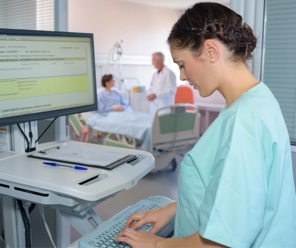
GP referral
A GP referral is a UK-specific term for when a personal doctor – a General Practitioner (GP) – writes to other medical professionals for further assistance with your healthcare, either for further diagnosis or for specific treatment.
How long do GP referrals take?
According to the NHS page on referrals for specialist care, the waiting time for a referral should be no longer than 18 weeks.
For some areas, this will be much quicker due to the niche nature of the patient’s complaint. Using a personal example, I only had a five week wait for the Speech and Language Therapy (SALT) team at Birmingham’s Queen Elizabeth Hospital back in 2023 to help with my oesophagitis, due to the uncommon nature of it. It can also be faster for community-based wellbeing programmes for things like weight-loss and quitting smoking.
People waiting for more common health problems and departments like Physiotherapy can see themselves waiting the full 18 weeks or more depending on local demand. This can unfortunately be exaggerated during the winter, or instances like heatwaves, where NHS usage increases significantly.
Electronic patient referral system
One way of supporting GPs with these referrals is to implement an electronic patient referral system. This would then serve as a GP referral tool and would host a GP referral form template and bring in much needed automation and a pre-emptive element to the administrative processes involved in escalating a patient’s care onto specialist professionals.
What is a referral management system?
The cheeky answer is that a referral management system is a piece of software that manages patient referrals. In the context of this article, we mean from clinician to clinician, supporting the care journey with automation and pre-generated forms that pass between doctors, nurses, and admin teams alike.
A GP referral management system can deliver a user-friendly tool for General Practitioners. There should be a services directory and the ability to track referrals, and secure communication channels so that clinicians and healthcare professionals can communicate back and forth regards a referral.
NHS e-Referral service
NHS Digital (since merged with Health Education England and NHS England) put the National Health Service in the UK into a position where referrals were being digitised, and this is supported by the NHS e-Referral service.
The NHS Standard Contract has mandated that since October 1, 2018, all NHS providers must use the e-RS as their only method of making and receiving patient referrals from primary care to secondary care services. This comes off the back of the prior Paper Switch-Off Programme at the end of 2016.
What is the NHS e referral service?
Commonly referred to as e-RS, the NHS e Referral Service is a digital platform for healthcare professionals to manage patient referrals from primary care providers (e.g. doctors’ practices) to secondary care services.
It was established so that GPs could refer patients for outpatient appointments with consultants, and so that patients were involved and had oversight through the NHS app to subsequently book and manage these appointments.
The reasoning behind the introduction of the e-RS, in the NHS’ own words, was for clarity and security, streamlined care, and reduced demand. Greater patient involvement in the referral process helps with adherence to appointments and this in turn helps maximise patient access to consultation and reduce the cost of missed appointments. Greater clarity helps with organisational oversight of service delivery, and the digitised communication channels are quicker than phone calls or paper letters.
Under the NHS England umbrella, e-RS allows patients to choose their initial outpatient appointment at a hospital or clinic. This can then be booked at the person’s GP surgery, online through the NHS app, or by phone. A two-week waiting period is in place to allow consultants to prioritise crucial care cases, such as those being referred with potential cancer symptoms.
The system isn’t perfect by any means – the NHS England page on e-referrals itself warns of issues regards the demand for services and staff shortages impacting availability and thus impacting choice. This isn’t news for UK residents, but it does show the importance of further optimisation and wider digitisation within the NHS to maximise healthcare delivery and patient choice.
E referral training
With devolution it’s not wholly clear how each region of the UK handles e referral training, but NHS England has an e-RS national training environment which is available to all users of the e-referral service.
As you’d expect it’s a mirror of the live NHS e-referral service, so it gives realistic interactions without the risk of impacting real patient data and individual referrals.

Challenges for Trusts & GPs
There are two primary challenges facing NHS Trusts and the GPs who work within them:
- Inefficiencies are time-consuming, and staff labour is doing work that could be simplified and automated by a software solution for a more streamlined approach to referrals, thus reducing the administrative burden and saving time.
- Communication about referrals is insufficient, and there’s a wish to remove any ambiguity in the process by introducing greater transparency for GPs and patients alike.
This has been backed up by testimony from clinicians, admins, and patients. Staff are worried about missing or incomplete referrals. Patients are worried about mistakes and admin holding up treatment or care – especially when waiting lists are problematic, GPs are frustrated by the time they spend chasing up the status of referrals and the lack of integration of referral software to their own clinical systems, and GP administrative staff are spending time handling the constant follow-ups from concerned patients.
Benefits of a GP referral system
Once you know the challenges facing GPs, you can appreciate the benefits of a GP referral system. Good quality referral software can deliver:
- Streamlined referral process: By automatically presenting a GP with the relevant referral form for the chosen service, you’re saving time. The GP can then trust the solution to carry the referral on to the correct destination clinician, removing the need for a manual search or dedicated email whilst still providing an audit trail for accountability.
- Timesaving through Efficiency: By using a GP referral system, data fields can be mandated to populate or fail to progress. This helps alert a GP or patient to the issue and saves the back-and-forth of fixing forms. The software can also automate notifications, which cuts down on the manual follow-ups via email or call, and helps meet the Trust’s Referral to Treatment targets.
- Better Communication: GPs want better coordination, and with a GP referral system there is a consistent data flow from them in Primary Care to the specialised services in Secondary Care; all with a clear audit trail, and with real-time status updates on the referral’s progress.
Our advice to prospective customers is to look for a solution that offers Centralised Integration. In the case of Access GP Referral, our software module seamlessly integrates with EMIS Community and EMIS Web, enabling referring GPs to select a service and complete the digital referral form directly within Rio.

Access GP Referral Management
This brings us to our solution – Access GP Referral Management. We designed our module to simplify the referral process by allowing to create and manage referrals directly within their system, integrating into our RioEPR software.
How does it work?
- A GP submits a referral, which can be sent directly from clinical systems like EMIS, to Trusts using RioEPR.
- Once done, the recipient service reviews it and marks it in Rio as Accepted, Declined, or More Information Required.
- GP feedback is added to the record to confirm the referral status, and likewise Trust clinicians can add comments and send feedback to the GPs regarding the referral.
- If the referral is accepted and the patient does not already exist in the system, a new patient record is automatically created in Rio, with the referral added to the caseload. If they do have a record, the system will add it to their existing files.
The data entered by the GP goes onto the patient’s record, but a PDF version of both the assessment form and the referral form is also uploaded for audit purposes and a hyperlink to the completed assessment form is inserted into the patient record as well. This automation not only eliminates the need for manual data entry but also ensures accurate and efficient processing, improving real-time collaboration and care delivery between GP systems and Rio.
Access GP Referral Management features:
- Referrals are sent as structured data for enhanced reporting and as an uneditable PDF snapshot for auditing purposes.
- Patient records are automatically created in Rio if one doesn't already exist, with the referral added to the caseload upon submission.
- Assessment forms can be manually added or removed.
- GP referrals are automated to share to the Rio EPR system, replacing manual data entry and reducing time and potential errors.
- GPs can view and update referral data in real-time, enhancing collaboration between GP systems and Rio, and improving care coordination.
- Tailored support available for various referral services, such as Podiatry, Diabetes, and MSK, reducing time-consuming manual configuration and potential errors in data entry and referral management.
Why we developed it:
- Current referral systems create a heavy admin burden with high referral volumes via emails, letters, and calls.
- Patient info is often inconsistent between Primary and Secondary care, requiring back-and-forth communication.
- NHS eReferral Service lacks tailored functionality for Community and Mental Health providers, resulting in time-consuming manual work.
- Trusts may need large teams to handle these processes.
- Single Point of Access (SPoA) teams can feature between 50 to 200 members of staff, which is a large group to employ and pay. Greater workflow efficiency can help reduce the volume of staff needed, freeing up funds for Trusts to allocate elsewhere.
Referral to Treatment (RTT) is a key performance metric in the NHS that measures the time taken from when a patient is referred by a GP (or other healthcare professional) to when they receive their first definitive treatment.
The goal is to ensure that patients are treated promptly, with the NHS aiming to complete 92% of patient pathways within 18 weeks of referral. RTT times are crucial for monitoring and improving the efficiency and effectiveness of healthcare delivery, and Trusts are required to hit targets.
Patient Referral System
A patient referral system or GP referral system is a very helpful piece of healthcare technology to have available to clinicians. We must be looking at every aspect of modern healthcare delivery to ensure that healthcare professionals are given as much support as possible to ensure the highest quality care. Digital tools are one way of doing this, and the return on investment through time-savings or greater care quality are evident across a myriad of different solutions.
It would be easy to assume that the NHS had things sewn up though with their e referral service. The problem is that these services experience high demand; a large volume of emails, letters and phone call from concerned patients. On top of this, the NHS eReferral Service does not fully meet the needs of Community and Mental Health providers, which then requires manual work to be linked up.
This is where The Access Group, and our Access Elemental GP Referral tool, seek to bridge that gap. The current state of affairs is that Trusts can have large teams of staff handling these processes. Personnel salaries are costly, and manual processes slow. It’s better to do it this way that to ignore community care and mental health referrals, but it’s better still to build upon the digital foundations established and enhance the referral process.

 AU & NZ
AU & NZ
 SG
SG
 MY
MY
 US
US
 IE
IE

